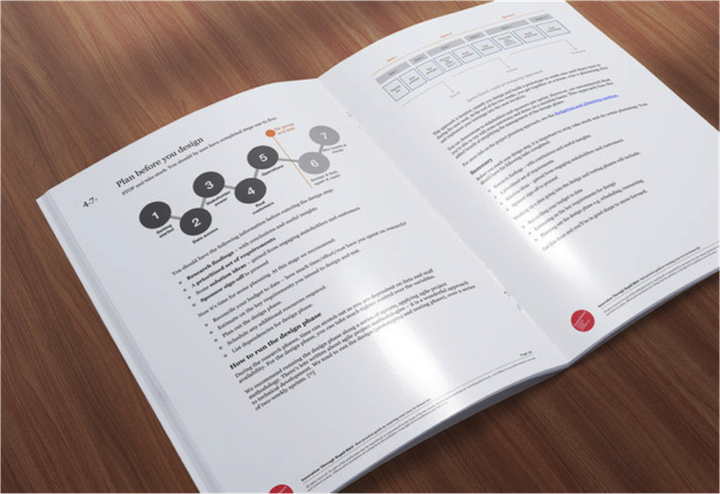Innovation through rapid R&D
Best practice guide to running your own in-house lab
In the summer of 2014, I decided to write down my approach to 'doing' UX. After delivering TORF, a funded R&D project I ran with my partners at Joylab, I knew my approach could work well for six-month plus R&D projects, to typical projects involving UX, UX-led innovation, down to five day hacks. It scaled and was relevant. More so, I was and still am, keen to share it. Econsultancy published it as a Best Practice Guide: How to run your own in-house innovation lab.
 My best practice guide (source: Econsultancy)
There continues to be real urge in organisations to develop innovation in-house and more and more, the relevance of User Experience Design (UX) is shifting front and centre and its importance is now understood at board-level. This is key, as proper UX design is very invasive and must change service and product delivery at a fundamental level, as much as projects changing from being run in a waterfall way to Agile, to much faster code release cycles. It's a process and cultural change.
At first, the thing I really wanted to share was a simple set of principles I follow. These are:
My best practice guide (source: Econsultancy)
There continues to be real urge in organisations to develop innovation in-house and more and more, the relevance of User Experience Design (UX) is shifting front and centre and its importance is now understood at board-level. This is key, as proper UX design is very invasive and must change service and product delivery at a fundamental level, as much as projects changing from being run in a waterfall way to Agile, to much faster code release cycles. It's a process and cultural change.
At first, the thing I really wanted to share was a simple set of principles I follow. These are:
- Be skeptical. The truth is always slightly to the left.
- Do just enough. And build momentum.
- Making mistakes means you’re making decisions.
- Stay small, go guerrilla.
- There are known knowns, known unknowns and unknown unknowns – keep this in mind.
- Don’t lead users, bloody listen!
However, that wasn't really useful to anyone on it's own. Though this is my approach in its core. I was actually going to have to explain my process, show some examples, give it context (within an industry) and within the context of the wider UX Design community. Rather than just write up another guide on doing UX, I decided to focused on two core areas: UX design for multi-channel environments focusing on retail; and a how-to guide for setting up your own in-house lab. Here is my first version:
How to run a pop-up lab
A guide to taking control of your omni-channel future...more
In steps the publisher Econsultancy. They liked it and wanted to publish a guide for the industry from us at Joylab - there was and is a real need to understand how to design for omni-channel experiences. However, it needed to be a little more 'detailed' as they put it. So over the next few months I wrote a more detailed guide, formuating my approach and giving it context. I ended up writing what felt like a dissertation again!
For several years now the work I've done has been much more service & product delivery orientated, designing for user touch-points across many channels i.e. web, mobile, social, to physical (e.g. events to in-store). However, my approach has remained the same, flexing across this, regardless of industry too (e.g. retail, charity, arts events, pharmaceutical). Where it has changed, has been an embrace of our developing industry practice across UX and IT: Agile project methodologies, LeanUX, start-up product development like creating MVPs through to the wonderfully developing [and sometimes worryingly] persuasive design approaches many practitioners are increasingly needing to employ. While writing this paper, I was keen to express my approach within a UX design context historically. I found myself increasing looking backwards across design and IT, to Skunkworks methodologies from the 1950s and rapid prototyping from the 1980s - to understand the position of my approach.
Since writing the report, I've run multiple other projects, from short hacks to bigger design projects. In addition, I've had the opportunity to talk at several events to explain the approach:
Below is my presentation from the Emerce conference which describes my approach in more (visual) detail:
My Emerce presentation on Slideshare
You can download the report from Econsultancy. If you haven’t got a subscription, check out the Abridged seven step process. If you have any feedback or want to join in the conversation around Lab Culture we set up a Lab Culture LinkedIn group.
 My best practice guide (source: Econsultancy)
There continues to be real urge in organisations to develop innovation in-house and more and more, the relevance of User Experience Design (UX) is shifting front and centre and its importance is now understood at board-level. This is key, as proper UX design is very invasive and must change service and product delivery at a fundamental level, as much as projects changing from being run in a waterfall way to Agile, to much faster code release cycles. It's a process and cultural change.
At first, the thing I really wanted to share was a simple set of principles I follow. These are:
My best practice guide (source: Econsultancy)
There continues to be real urge in organisations to develop innovation in-house and more and more, the relevance of User Experience Design (UX) is shifting front and centre and its importance is now understood at board-level. This is key, as proper UX design is very invasive and must change service and product delivery at a fundamental level, as much as projects changing from being run in a waterfall way to Agile, to much faster code release cycles. It's a process and cultural change.
At first, the thing I really wanted to share was a simple set of principles I follow. These are:
